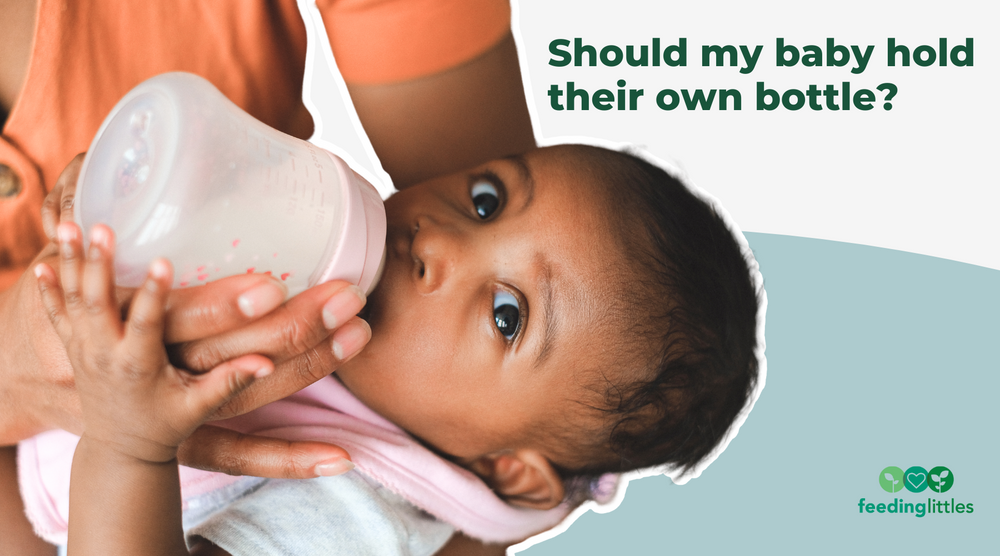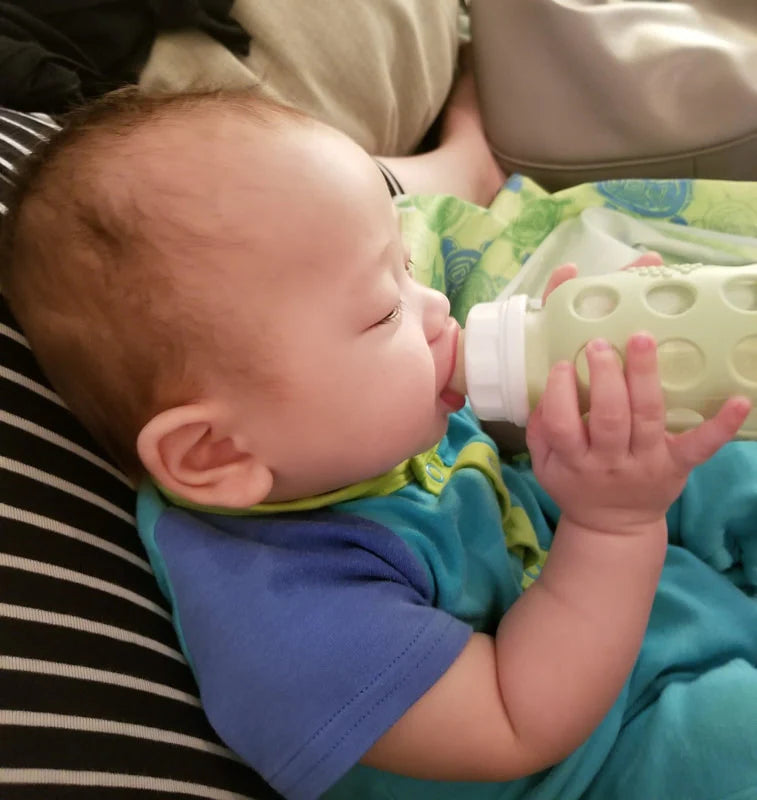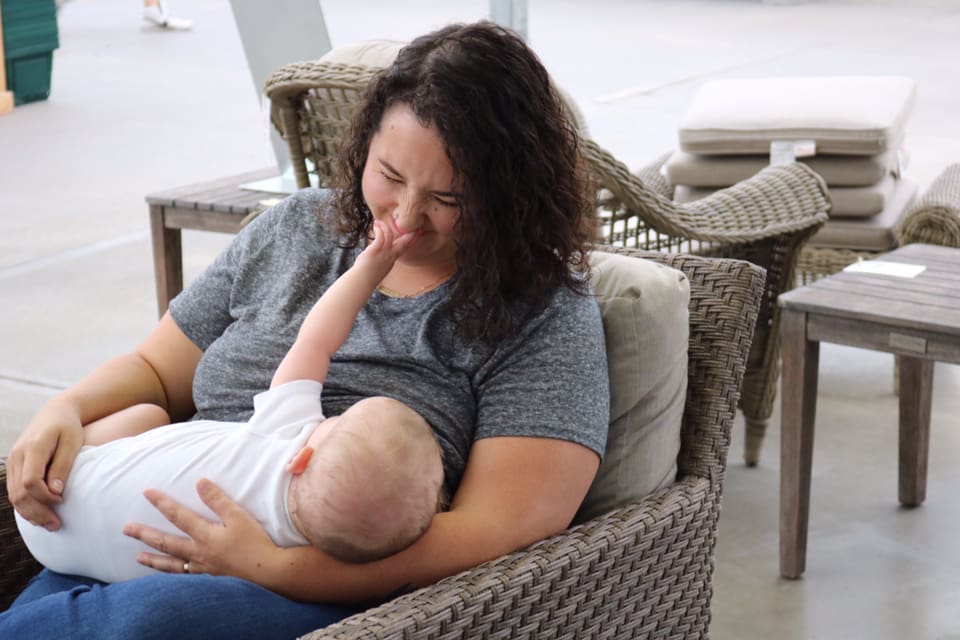
One question we have heard often is, “Should my baby be able to hold their own bottle?”
The short answer: yes. We want babies to be able to hold their own bottle, as doing so is an important skill and strength-building exercise that develops their hands at a midline position. However, for a variety of reasons we always want to hold/supervise baby as they bottle feed – more on this later.
Note: taking milk from a bottle is a skill that many exclusively breastfed babies don’t necessarily need to do. Some babies never accept a bottle and go straight to a cup. If your baby doesn’t need to or won’t take a bottle, they’re not missing a key developmental skill as long as they’re also practicing “hands to midline” in other capacities. If your breastfed baby refuses bottles, check out this blog post.
First, let’s discuss midline position, why it’s critical in your child’s development, and how to help promote bringing hands to midline or crossing midline.
What is “midline,” and why does it matter?
The midline is an invisible line from the top of our head to bottoms of our feet, separating the two sides of the body. We cross that imagery line any time we move a foot, hand or eye into the space of the other foot, hand or eye. We also cross the midline with our tongues when we use the tongue to laterally move food from one side of our mouths to the other.
The ability to freely cross the midline allows us to do almost every daily life activity, including bathing, brushing our teeth and hair, driving a car, using a keyboard or playing sports. Midline is necessary for visual tracking. We rely on visual tracking for reading, as our eyes must continually cross the midline as they scan the page. Watch a young reader as they learn to read a simple book: at first, they may have to turn their head slightly as they read the book, then they progress to pointing to the works as their heads stay mostly still. Eventually they no longer need to point to the words as their eyes do all of the work – crossing midline has become automatic.
Not only is crossing the midline essential, but it’s also important for your baby to be able to hold objects at midline. When toddlers can’t hold their own cup, they struggle to stay hydrated. Babies who can’t successfully hold food at midline may have trouble learning how to self-feed. Check out baby Bryson (7 months), below, holding his own water cup at mealtime. (For more on water and hydration needs in babies, toddlers and kids, click here.)
Thus, the reason why we want baby to eventually hold a bottle is because it leads to holding other objects like water cups, food, toys and eventually books, crayons and pencils in their hands. It’s part of a progression that eventually supports independence and learning.

OK, so midline is important…but how do we develop it during bottle feeding?
Around 3 months of age, babies begin to notice touch inputs in their hands as they take shape of an object like a rattle, toy, bottle or breast. By 4-6 months, babies begin to transfer objects from hand to hand. This is a very exciting fine motor milestone – you may notice that your baby practices this repeatedly. It’s essential in their development of a sense of midline.
Since we know hands at midline are important, here are some techniques I use to help babies work toward holding their bottle – and eventually other objects – at midline when you are holding them for a feeding. We always want to hold/supervise babies with bottles.
- When holding and feeding your baby using a bottle, encourage your baby’s hands toward the midline of their own body. This is help with baby self-regulation and state control needed to stay engaged with the sucking process.
- While feeding your baby with a bottle, help bring your baby’s hands towards your hands – they may even be able to hold onto one of your fingers. Not only is it great for their fine motor development, but it’s something you'll remember fondly one day!
- Gently guide your baby’s hand to the bottle using a hand-over-hand technique..
- If your baby becomes easily distracted during a bottle feed, add a rubber band or hair tie to the near top of the bottle (examine it for safety first). This little added texture can help your infant be a little more interested in the feed, stay more engaged, and participate for longer periods of time. It also stimulates their hands to locate this texture.
- We all eat better when our feet are supported. If your baby’s arms don’t come to midline or if they reach behind them during a feed, gently draw their arms to midline and put a pillow or arm under your baby’s feet. Adding stability in this way allows for increase movement and forward reaching for the bottle or your finger.
- As your baby begins to open their hands during a feed, teach them to gently pat the bottle with their hand.

Some breastfeeding moms choose to not give a bottle of expressed milk to baby and go straight to a cup when offering water (6+ months). Perhaps mom doesn’t respond well to a pump or baby refuses a bottle. If your baby doesn’t ever take a bottle, they’re not missing out on a developmental skill. They don’t need to learn how to drink from a bottle to be a successful self-feeder and cup drinker.
It’s still important for breastfed babies to bring their hands to midline while feeding. Below are some techniques we use with my breastfeeding clients to help promote hands to midline:
- While breastfeeding your baby, help bring their hands towards your hands. They may even be able to hold onto one of your fingers. One of your best breastfeeding memories may come from your baby grasping your finger for the first time.
- Help your baby bring their hands to the breast as they nurse. You can place your hands over their hand to help relax and encourage their hands to stay in this position. As your baby gets older, they may begin to squeeze or manipulate the breast to get the milk to flow faster – this is normal (and very smart of them, no)?
- We all eat better when our feet are supported. If your baby’s arms don’t come to midline or if they reach behind them during a feed, gently draw their arms to midline and put a pillow or arm under your baby’s feet. Adding stability in this way allows for increase movement and forward reaching for the bottle or your finger.
- As your baby begins to open their hands during a feed, teach them to gently pat the breast with a hand-over-hand technique. Patting during feeds can establish a calming rhythm that can help babies focus on eating.
- Some moms wear teething necklaces made of safe materials that also help their babies focus during breastfeeds.
My baby can hold their own bottle? Can I just let them do their own bottle feeds?
Once your baby has the ability to hold their own bottle, many parents want to let them bottle feed independently without holding baby. You may see babies drinking bottles independently and wonder if your baby is “too old” to be held for bottle feeds.
Hear us out, friends. We are realistists. We completely understand that sometimes it’s just easier to hand baby their bottle in the stroller at the zoo and let them do their thing once they’re able to hold it themselves. We always come from a place of gentle education without judgment. Take this information and do what works best for your family.
The concerns we have regarding independent bottle feeding are two-fold:
- Safety issues
- Less bonding and interaction
Safety
The flow of a bottle can be fast, and sometimes babies can’t keep up with it or can’t pull the bottle away while drinking. This is why it’s especially important to avoid propping a bottle for baby to drink. When a baby is unsupervised while drinking a bottle, their risk of overeating or choking on the liquid is increased. Furthermore, a baby drinking on a completely flat surface like in a crib has an increased risk of ear infections, as milk can pool in their mouth and flow back into their Eustachian tubes.
Note: if you are breastfeeding, laying a baby flat during breastfeeds (for example, while side lying) does not carry the same ear infection risk because milk doesn’t pool in their mouth the same say.
When babies drink from a bottle while sitting straight up (e.g. in a high chair) they have to tilt their head back to drink, which leads to poor sucking skills. If your baby needs milk while seated, we recommend working on a cup instead of a bottle. Start with an assisted open cup and work to a straw or other cups as described in this post.
Bonding and Interaction
Bottle feeding, like breastfeeding, is meant to be an interactive experience. Similarly to family meals with solid foods, bottle feeding time is an opportunity to bond. Holding your baby while they bottle feed – even if they hold their own bottle – promotes communication, language, social interaction, eye contact, rhythm (if you rock or sway), trust in their caregivers, and a sense of security. Encourage them to hold their own bottle when they’re ready, but I encourage you to hold them at a 45 degree angle and interact with them while they bottle feed.
What if my baby won’t sit still for bottle feeds?
Older babies (7-12 months) start to get mobile and may not want to sit still for a bottle feed. If they have been crawling, cruising or walking with their bottle it can be hard to get them interested in cuddling during bottle feeds. Sometimes their refusal to sit still may tell us more about their development than we realize.
- If your baby will only take a bottle when distracted by screen time or while moving, they may be ready for a cup for at least a few of their milk feeds.
- Be consistent with routines. Your baby will be more calm and focused when they know what to expect. Many babies have their best bottle intake first thing in the morning, before naps and before bed. Use that time to snuggle and bond if baby will let you.
- Many babies don’t eat or drink as well when they’re teething. Watch your baby for signs of dehydration (low urine output, dry lips/mouth, tearless crying) and talk to your doctor ASAP if you suspect that your baby may be dehydrated.
- Trust your gut. Sometimes poor bottle drinking is related to bigger concerns like digestive problems, sensory issues, oral-motor weakness etc. Work with your provider if you suspect something is up, and don’t hesitate to reach out to your state’s Early Intervention Program (if you’re in the US) to schedule an evaluation.
We hope this answers the kind of complicated question, "Should my baby hold their own bottle?"
